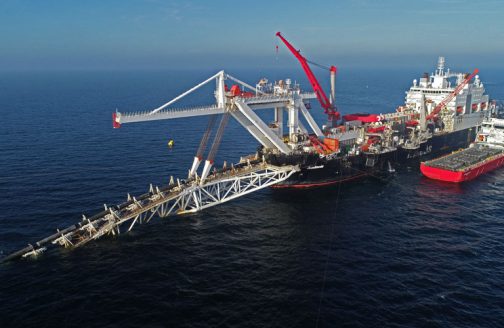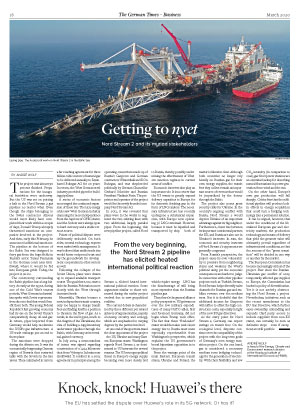Nord Stream 2 and its myriad stakeholders
 Laying pipe: The Audacia at work on Nord Stream 2 in the Baltic Sea
Laying pipe: The Audacia at work on Nord Stream 2 in the Baltic SeaCredit: DPA/Bernd Wüstneck
The project was almost 90 percent finished. Preparations for the inaugural festivities were underway. But the US was set on putting a halt to the Nord Stream 2 gas pipeline no matter what. Even though the ships belonging to the Swiss contractor Allseas would most likely have completed their work within a couple of days, Donald Trump abruptly threatened sanctions on companies involved in the project. And then, early this February, he announced additional sanctions. The pipeline at the bottom of the Baltic Sea was designed to ferry gas from the huge fields in Russia’s arctic Yamal Peninsula to the German coast near Greifswald, where it would be fed into European grids. Today, the project is on ice.
The controversy surrounding the Baltic pipeline has a long history. As early as the 1950s, during one of the Cold War’s tensest periods, West German industrialists spoke with Soviet representatives about a deal that would benefit them both. The young Federal Republic’s fast-growing economy had its eye on the Soviet Union’s comparatively cheap oil and gas. In return, pipes imported from Germany would help modernize the USSR’s gas infrastructure. A US trade embargo put an end to those plans.
The sanctions were dropped during the détente era. It was the economically burgeoning German region of Bavaria that restarted talks with the Soviets in the late 1960s. They culminated in 1970 in a far-reaching agreement for three billion cubic meters of natural gas to be delivered annually to Essen-based Ruhrgas AG for 20 years. In return, the West German steel industry provided pipes for building pipelines.
A series of economic factors encouraged the continued expansion of these ties. The 1973 energy crisis saw West German industry clamoring for more independence from the caprices of OPEC states. And the Soviets were always open to hard currency and a stable revenue source.
Points of political dispute were deliberately excluded. On both sides, neutral technology experts were tasked with management. It was believed that stable trade ties would foster reciprocal trust and lay the groundwork for development cooperation in other sectors as well.
Following the collapse of the Soviet Union, plans were drawn up to expand available transport routes. The goal there, too, was to link the Russian Federation more closely with the West through increased trade.
Meanwhile, Ukraine became a new, independent transit country, only too happy to charge transit fees and finding itself in a position to threaten the flow of gas. As a result, in the mid-1990s, much to the chagrin of the Ukrainians, the idea of building a supplementary underwater pipeline through the Baltic, with Germany as its terminal, gained currency.
In July 2004, a memorandum of intent was signed regarding construction of a 1,224-kilometer duct from Vyborg to Lubmin near Greifswald. It resulted in a 2005 agreement in principle among the operating consortium made up of Russia’s Gazprom and German contractors Wintershall and E.On Ruhrgas, and was shepherded politically by German Chancellor Gerhard Schröder and Russian President Vladimir Putin. The proprietor and operator of the project would be the newly founded company Nord Stream AG.
In 2013, it was revealed that plans were in the works to augment the two existing lines with two additional, largely parallel pipes. From the beginning, this new pipeline project, called Nord Stream 2, elicited heated international political reaction. Some arguments similar to those witnessed during the earlier project evolved due to new geopolitical realities.
The current debate is characterized by three different yet related spheres of argumentation, namely economy, security and ecology, which are emphasized to varying degrees by the parties involved.
At one end of the spectrum stand the clear opponents of the project – the US, Ukraine and many Eastern European states. Washington regards Nord Stream 2 as detrimental to US interests for several reasons. The US sees a geopolitical threat in Europe’s energy supply becoming even more closely tied to Russia, thereby possibly undermining the effectiveness of Western sanction regimes in current areas of conflict.
Economic interests also play an important role. It is no secret that the US wants to greatly expand delivery capacities to Europe for its domestic fracking gas in the form of LNG tankers. The necessary infrastructure has recently undergone a substantial expansion, with Europe now operating 36 LNG terminals. However, because it must be liquefied and transported by ship – both of which require energy – LNG has the disadvantage of still being more expensive than the Russian pipeline gas.
Then there’s the general alliance policy perspective. US grievances over the low military expenditures of many NATO allies, first and foremost Germany, did not begin when Trump took office. The fact that these “freeloader” states would then also seek closer energy ties to Russia must seem especially reprehensible from Washington’s perspective, which explains the US government’s broad bipartisan opposition in to the project.
From the vantage point of the main Eastern European transit states, Ukraine and Poland, the matter is likewise clear. Although both countries no longer rely heavily on Russian gas for their own energy supplies, the transit fees they collect remain an important source of revenue that would be jeopardized by the detour through the Baltic.
The project also poses great security risks for Ukraine. In the country’s ongoing conflict with Russia, Nord Stream 2 would deprive Ukraine of an important advantage against its big neighbor. Furthermore, closer ties between its important continental partner, the EU, and Russia are also not in Ukraine’s interests. In sum, the economic and security interests of Nord Stream 2’s opponents are generally congruent.
From Russia’s perspective, the project eases its own vulnerability to pressure from neighboring states and weakens the West’s political unity, yet the economic consequences are harder to judge. In connection with other pipeline projects such as Turkish Stream, Nord Stream helps diversify sales channels for Russian gas and stabilize revenue over the medium term. But it is doubtful that the additional income for Gazprom will suffice to offset the high construction costs, especially in light of the new EU gas directives.
As the entry point for Nord Stream 2, Germany can expect savings on transit fees. On the ecological level, disputes continue over the compatibility of the project with the long-term goals of Germany’s own energy transition project. On the one hand, gas is considered a necessary medium-term bridging technology for the generation of electricity. With their flexibility and low CO2 intensity (in comparison to coal), gas-fired power stations are an essential backup for absorbing natural fluctuations in power generation from wind and the sun.
On the other hand, Europe’s own gas production will fall sharply. Critics fear that the additional pipeline will produce lock-in effects in energy acquisition that could turn a bridging technology into a permanent solution.
It can be argued, however, that under the conditions of the liberalized European gas and electricity markets, the production technology and means of delivery that yield the greatest value will ultimately prevail regardless of infrastructural conditions, so that the success of the “green transition” will be decided in one way or another by the market.
The European Commission has become increasingly critical of the project. Ever since the Russian-Ukrainian gas conflict of 2005 temporarily affected gas supplies to Europe, the Commission has backed a policy of diversification. Yet it is not actively obstructing the Nord Stream 2 project. Nevertheless, initiatives such as the recent amendment to the EU Gas Directive, which further eases ownership unbundling and expands third-party access to include suppliers from non-EU states, can certainly be seen as defensive steps – even if exceptions are still possible.
André Wolf
is head of the Energy, Climate and Environment research division at the Hamburg Institute of International Economics (HWWi).




